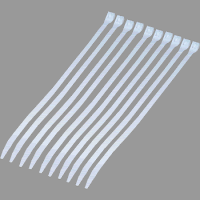In this article I'll be discussing which tools I consider to be most important and how to use them effectively.
 Antistatic Wrist Strap
Antistatic Wrist StrapComputer components are easily destroyed by static electricity, since they are 'static sensitive'. An antistatic wrist strap usually consists of a band with a small metal plate that wraps around the users wrist at one end, and connects to an earth point at the other (a plug) and each end is connected by a wire.
Whenever you open the case you should always ensure that you are wearing an antistatic wrist strap as this can make the difference between fixing or frying components!
No PC user who wishes to carry out any kind of maintenance on his PC can really manage without the humble Philips screwdriver. This is used for all the screws usually found in a PC, such as those on the case panels, drives, motherboard and fans.
 Small Torch
Small TorchAlthough it's always best to work on your PC in a well lit area, this is not always possible. A small torch, such as a mini-maglite can make life a great deal easier when working on the inside of a computer case. Alternative's include the snake light, which is a clip on lamp that can be repositioned in many ways to direct light exactly where it's needed, although this can be an expensive option.
 Paint Brush
Paint BrushA small, stiff bristled,
¼” paint brush with a long handle is great for cleaning out dust and debris from within a PC. Used effectively you can clean out the hardest to reach areas, such as within the heatsink fins, fan blades, corners of the case and on the motherboard.
When using a brush to clean out your PC, start at the top of the case, and work your way down towards the bottom. Then, tilt the case towards you and brush the dust etc. out of the case.
It is important to work slowly and carefully as you don't want to be heavy handed enough to damage any components such as capacitors on the motherboard.
 Compressed Air
Compressed AirCompressed air comes in two forms, that from an aerosol can that can be purchased from a great deal of component retailers, or from a compressor which is a large machine that plugs in to the mains.
For most people the canned air type is the best and most accessible, since it is cheap and can be taken to the workspace rather than having to take the PC to the compressor.
Always read the cautionary instructions when working with canned air, since it is an aerosol and therefore can be potentially dangerous when used incorrectly.
Compressed air is great for cleaning dust from otherwise impossible to reach areas such as within the PSU.
Always blow dust away from you, and make sure that the dust has somewhere to go. You really don't want to get a mouthful of human and animal skin cells, smoke dust or animal hair in your mouth and eyes!
 Another Computer
Another ComputerThis I guess is not really an essential for most people, although personally I have many times found myself working on a PC (which is turned off) and desperately in need of an internet connection to look up some help files, or a user manual etc. If at all possible, another computer close by, such as a laptop or even a PDA can be a great time saver and help prevent masses of frustration.
And that's it!
There are some other bits and pieces that I always keep at hand when maintaining a PC. These are non essential items, but can come in handy.
 Zip-Ties
Zip-TiesThese I use to secure cables, or to bind them together to keep them out of the way. This helps to create greater airflow through the case which in turn cools components more effectively thus pre longing their operating life.
 Cable Wrap
Cable WrapI use the simple, cheap kind that you wind around cables. This is great stuff that helps to prevent cables being worn to the bare wire which can cause all sorts of problems.
You can also use it to bind many cables together that are running in the same direction, which leads to less mess inside the PC.
 Side Cutters
Side CuttersA pair of plier-like side cutters are used to chop off the tail's from zip-ties and excess cable wrap, again this is not essential but helps maintain a tidy case.
Have you found this guide helpful? Do you have any other essential tools that you think I should have mentioned?
Please leave your comments below.


This comment has been removed by a blog administrator.
ReplyDeleteAnother handy item to have round is a tube of thermal paste. Sometimes you have to remove the heatsink to get to a tight area, thus needing to reapply thermal paste to the heatsink.
ReplyDeleteOtherwise, that list looks pretty good. Good job!
@john d
ReplyDeleteThat's a very important addition and I have no idea how that escaped the list!
Since I am currently considering a rebuild of my gaming PC I may take some photo's and make some notes so that I can do a post in the near future on Thermal Interface Compound use and application.
Cheers for pointing this out.